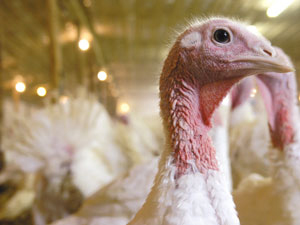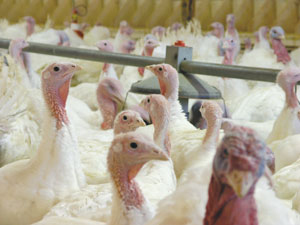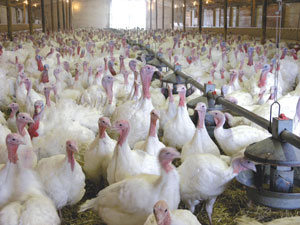
Future Challenges
By Hafez Mohamed Hafez
Features New Technology ProductionChallenges and opportunities confront turkey producers
The modern turkey industry, oriented for high production and better
quality at low cost, demands continuously efficient and goal-oriented
health care to prevent the development of disease conditions.
Challenges and opportunities confront turkey producers
The modern turkey industry, oriented for high production and better
quality at low cost, demands continuously efficient and goal-oriented
health care to prevent the development of disease conditions.
 |
|
| CHALLENGING TIMES The turkey industry faces global competition, increasing feed costs, and changes in consumer perceptions and demands. |
The turkey industry and veterinarians currently face new challenges, which include strong global competition, steady increases in the cost of feed,legislation, changes in social, political and consumer perception and demands and the emergence of some diseases.
CHALLENGES
Strong global competition
The European turkey industry is currently under strong global competition. This is accompanied by an economic threat from turkey meat imports, especially from Brazil and Chile, and with the movement of the large producing companies to other countries with lower production costs.
Steadily increasing cost of feed
The major item of meat turkey production cost is the feed. It is a major disadvantage for Europe that it must import soya as a protein source. Turkeys are particularly hard hit because of their high protein requirement. In addition, during the last seven years, the turkey feed context has totally changed. The first change happened at the end of 2000 with the withdrawal of the meat meal and animal fat in the feed. This change happened not long after some Antibiotic Growth Promoters (AGP) had been banned or were not used in the EU, this resulted in a marked increase of the feed conversion rate (FCR) and a dramatic increase in the incidence of dysbacteriosis and necrotic enteritis. In addition, in the future the increase of biofuel and biogas production will reduce the available land for food grains and feed production, which will lead to a considerable increase of feed costs for animal production.
Legislation
The ban of Dimetridazole and NifursolN, which were used for the prevention of the Blackhead Disease in turkeys, resulted in the emergence of the diseases in layer and turkey flocks in Europe in recent years. Also, for the treatment of turkeys as food-producing animals, only a few authorized pharmaceutical veterinary products are available. Therefore, veterinarians are forced to seek exceptional permissions to administer drugs that are not authorized for use in these animals. In cases of exceptional use of a medicinal product, licensed for another food-producing animal an additional problem is given by the necessity to fix long withdrawal periods on meat (28 days) making it nearly impossible to treat flocks shortly before slaughter.
Furthermore, the withdrawal time for same product may vary greatly even within EU-member states.
 |
|
| Food safety is another challenge. Controlling foodborne organisms requires a broader understanding of how microbial pathogens enter and move through the food chain, as well as the conditions that promote or inhibit growth for each type of organism
|
Social, political and consumer
Currently, there is great concern that serious animal welfare and health problems might have been caused already due to genetic selection practices within the turkey industry.
The fact is that genetic selection practices within the turkey industry have achieved significant progress in terms of growth rate, better feed conversion, better meat yield and low production cost. All the time this was accompanied by continuous improvement in husbandry practices, nutrition, and disease control. The most outstanding and visible change in modern turkeys compared to their ancestors is the rapid growth and the higher percentage of breast muscle.
As a consequence, it is important to understand the relationship between genetic selection pressures and other factors that may have a subsequent impact on the health conditions. This includes the effects on the growth and development of supporting structures such as bone and blood supply. Compared to traditional lines the highly selected birds have reduced cardiopulmonary capacity in relation to their muscle mass, as the ratio of heart and lung development has strongly decreased in modern turkeys.1,2 This physiological imbalance causes problems such as sudden death syndrome, aortic rupture, deep pectoral myopathy and skeletal disorders, which currently receive a lot of attention as a cause of concern from the animal welfare point of view. They are mostly accompanied by economic losses for turkey meat producers due to mortality, predisposition to cannibalism, retardation of growth, increase of the condemnation rate and downgrading at the processing plant. The most common problems of the musculoskeletal system related to fast growth comprise dyschondroplasia and footpad dermatitis. The incidence and severity of both can be influenced by nutrition and genetic selection.3,4
 |
FOOD SAFETY
The loss of the consumer’s trust and confidence in the quality and safety of poultry meat is a further challenge. Turkey meat can harbour different foodborne pathogens. Many reports from recent years have shown that different Salmonella serovars and Campylobacter spp. are the most common causes of human foodborne bacterial diseases linked to poultry. In addition, the development of antibiotic resistance in bacteria, which are common in both animals and humans, is an emerging public health hazard. Controlling these foodborne organisms requires a broader understanding of how microbial pathogens enter and move through the food chain, as well as the conditions that promote or inhibit growth for each type of organism.5
Many different Salmonella serovars have been isolated from turkeys but their exact number is difficult to estimate. Some serovars may be the predominant for a number of years in a region or country and may then disappear to be replaced by another serovar. In 2003, the European Union adopted a Council Regulation 2160/2003/EC on the control of salmonella and other specified foodborne zoonotic agents. This regulation covers the adoption of targets for the reduction of the prevalence of specified zoonoses in animal populations at the level of primary production. Commercial turkeys should be examined with effect from 84 months after the enforcement of this regulation (the year 2010). Fresh poultry meat may not be placed on the market for human consumption when salmonella was detected in 25-gram sample. The criterion laid down does not apply to fresh poultry meat destined for industrial heat treatment or another treatment to eliminate salmonella in accordance with Community legislation on food hygiene. Another problem related to food safety is campylobacter, which is the leading cause of zoonotic enteric infections worldwide. Campylobacter infections in humans are mainly transmitted by contaminated food. No evidence has been found either for vertical transmission or for horizontal transmission from one flock to the next via persistent house contamination.
However, since the organism has been detected in the intestines of most slaughtered turkeys, the major route for campylobacter contamination of poultry appears to be the horizontal transmission from the environment.6 Investigations indicated that the external campylobacter load per chicken is increasing during transport, defeathering and evisceration, and decreasing at the other processing steps studied, with an overall reduction of the mean load from production –to consumption of about four to five logs.7 Good hygienic practice protocols should be prepared and strictly followed in all stages of production. Biosecurity should be improved throughout the production chain. Since campylobacter is found in the environment, hygienic barriers should be constructed to keep them outside the house.
EMERGENCE OF SOME DISEASES
Diseases of turkeys remain of major economic importance. Many of these diseases once re-emerging or introduced into a geographic area can explode into an epidemic and may have a significant negative effect on international trade. Respiratory as well as enteric disorders are two important groups of diseases affecting turkeys. They continue to cause high economic losses in many areas of the world due to increased mortality rates, decreased weight gain, increased medication costs, and increased feed conversion rates. The main challenge for veterinarians is the shortage of licensed therapeutic substances and vaccines for turkeys.
Currently avian influenza (AI) attracts a lot of attention worldwide. In the past, outbreaks due to HPAI H5 and H7 viruses were considered rare events in domestic poultry.
However, further outbreaks have occurred since 1999, resulting in several episodes involving many countries. Since December 2003, epidemic influenza due to a highly pathogenic H5N1 virus strain has devastated the poultry industry and recent outbreaks in commercial turkey flocks in some European countries were observed. The continuing spread of H5N1 appears to be related to two factors: spread through movement of poultry (legal as well as illegal) and spread through wild migratory birds. In the EU the diagnosis and control of AI should be carried out in accordance with Council Directive 2005/94/EC.
Although vaccination is an option as a part of AI control, the currently available vaccines seem to induce a higher level of protection in Gallus gallus birds than in turkeys.8,9
CONCLUSION
Turkey diseases and infections are associated with severe economic losses and that is why early recognition and monitoring programs are essential in managing the infections.
Generally, improvements in all aspects of management, biosecurity, education as well as enhancing the awareness of all people involved throughout the poultry production chain are essential. In the long term, development of turkey lines that are genetically resistant to some pathogens should progress. Further attention must be paid to the development of efficient vaccines against bacterial infections in order to reduce the use of antibiotics as well as enhancing the licensing of drugs for veterinary use.
Presented at the XXIII World’s Poultry Congress in Brisbane, Australia
REFERENCES
1. Norci, C. and Montella, L. (2003). Turkey welfare: Is it only a management problem? In: Turkey Production: Balance act between consumer protection, animal welfare and economic aspects. (ed. H. M. Hafez), Publisher Ulmer Verlag, Stuttgart, Germany, ISBN:3-8001 -4630 -4, pp.143 -148.
2. Havenstein, G.B., Ferket, P.R., Grimes, J.R., Qureshi, M.A. and Nestor, K.E. (2004). Changes in the Performance of Turkeys 1966-2003. Proceedings of the 27th Technical Turkey Conference, pp. 11 -18.
3. Farquharson, C. and Jefferies, D. (2000). Chondrocytes and longitudinal bone growth: the development of tibial dyschondroplasia. Poultry Science, 79: 994-1004.
4. Mayne, R.K. (2005). A review of the aetiology and possible causative factors of foot pad dermatitis in growing turkeys and broilers. World’s Poultry Science Journal, 61: 256-267.
5. Hafez, H.M. (1999). Poultry meat and food safety: Pre- and post-harvest approaches to reduce food borne pathogens. World’s Poultry Science Journal, 55: 269-280.
6. Hafez, H.M., Schroth, S. Stadler, A. and Schulze, D. (2001). Detection of salmonella, campylobacter and verotoxin producing E. coli in turkey flocks during rearing and processing. Archiv fur Geflugelkunde, 65 :130 ñ136.
7. Anderson, S., Christensen , B.B., Fazil, A., Hartnett, E., Lammerding, A., Nauta, M., Paoli, G. and Rosenquist H. (2003). A draft risk assessment of Campylobacter spp. in broiler chickens. Joint FAO/WHO Activities on Risk Assessment of Microbiological Hazards in Foods.
8. Capua, I. and Marangon, S. (2006) . Control of avian influenza in poultry. Emerg. Infect. Disease, 12: 1319 -1324.
9. Ortali, G. (2006). Vaccination against avian influenza in Italy: field experience in an integrated poultry operation. Proceedings of the 6th International Symposium on Turkey Diseases, Berlin, (ed. H.M. Hafez), Publisher DVG -Service-GmbH, Giessen Germany, ISBN: 3 -939902-04-7, pp. 275 -284.
Print this page